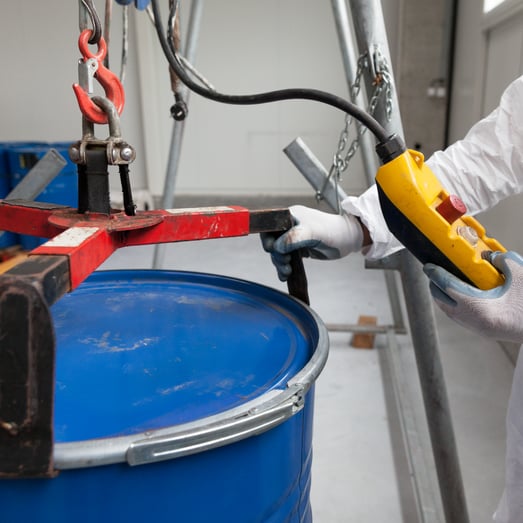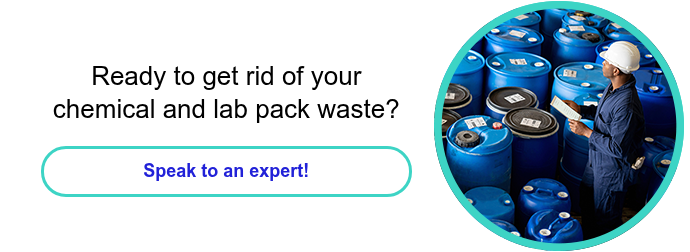Lab Packing Solutions: Risks, Best Practices, and Provider Selection
July 30, 2025

Environmental, Health, and Safety (EHS) leaders and their counterparts in operations, sustainability, and finance know only too well the challenges that containerized and small quantities of waste can create . From the storage closet to the lab, hazardous materials can accumulate and present threats to safety, compliance, and an organization’s bottom line. Yet these risks can be tamed and even transformed into opportunities for cost savings and sustainability through thoughtful planned clean-outs empowered by world-class lab packing solutions.

What Are Lab Packing Solutions?
Lab packing is a specialized form of waste removal that focuses on managing small quantities of waste in a cost-effective manner. Qualified Field Chemists, trained in both waste and transportation regulations, provide proper segregation, waste characterization, container selection and packing to ensure safe transport and disposal of your small quantities of waste.
Lab packing services can be scheduled on a routine or as needed basis, but whenever the end of the year approaches, it’s important to plan for scheduled services to ensure that your facility locks in the service it needs to continue its operations compliantly.
Why Planned Cleanups Matter
In 40 CFR, Part 262, the U.S. EPA establishes storage rules for generators of hazardous waste. These rules mandate storage limits, working with a qualified lab packing and disposal provider can allow for scheduling services in advance to ensure that these storage limits are not exceeded.
Scheduling services in advance has at least three clear advantages:
- First, it resets your regulatory clock. Any container reaching its storage limit must be shipped off site for disposal. Advanced scheduling of services helps you avoid storage exceedances, violations and potentially steep fines – some of which can reach tens of thousands of dollars per day for each violation. What's more, is sticking to a pre-established schedule helps businesses adhere to their waste management and environmental performance commitments with greater predictability.
- Second, it mitigates safety risks. Over time, chemicals can decompose and create unwanted by-products making disposal more difficult and hazardous – like uncovering forgotten peroxide-forming solvents like tetrahydrofuran, or unstable reagents such as dry picric acid, for example.
- Finally, it offers greater financial stability. By scheduling your lab packs and waste shipments in advance you will have more control over timing and costs, and have a greater ability to ensure consistency in your annual disposal spend. It may also enable you to lock in favorable disposal rates or capitalize on promotional offers before service bookings fill up.
The True Costs of Mismanagement
When containerized wastes and small quantities of hazardous materials are improperly managed, new hazards can be introduced, storage limits can be violated, and the risk of employee exposure to hazardous chemicals can increase safety issues. For example, groundwater contaminated by heavy metals, soil rendered infertile by persistent organic pollutants, and airborne hazards from evaporating volatiles all pose profound environmental threats. On the human side, OSHA reports that exposure to corrosive acids or toxic solvents can cause acute burns, respiratory distress, and chronic illnesses; while mixing incompatible wastes such as cyanides with acids, or flammables with oxidizers can trigger violent reactions, fires, or explosions.
Financially, the misclassification or improper segregation of a waste stream can multiply disposal costs twofold, or even tenfold. Manifest fees, lab-pack surcharges, and treatment premiums quickly add up. Beyond immediate fees, organizations can face a host of regulatory fines (tens of thousands of dollars per day under EPA enforcement) and swift reputation damage that can depress stock prices and invite lawsuits and other legal risks when a company is found operating out of compliance .
Mitigating Hazards
Knowing your storage limits and planning in advance will do wonders for your compliance efforts. Partnering with a strong service provider will take them to the next level.
"Next-level" hazard mitigation begins with accurate waste characterization. Detailed profiles, complete with chemical names, concentrations, and relevant Safety Data Sheets (SDSs), guide both safe handling and acceptance by downstream waste facilities. This documentation will assist in determining the regulatory status of the waste stream and ensure all appropriate steps are followed to mitigate the hazards associated with the waste.
Laboratories, maintenance areas, cleaning closets and smaller containers of chemicals can easily accumulate over time. Monitoring these areas and planning for routine removal can also assist in ensuring all work areas remain safe for employees. A recurring inventory audit, ideally supported by waste management software, can track batch numbers, quantities, and storage locations. Analytical tests such as the Toxicity Characteristic Leaching Procedure (TCLP) and pH verification can cement your waste determinations, while meticulous recordkeeping of test results and SDSs will help you maintain audit trails.
Segregation protocols are equally vital. Incompatible waste streams (acids and bases, flammables and oxidizers, halogenated and non-halogenated solvents, organics and inorganics) must reside in distinct cabinets or areas to prevent inadvertent mixing. For example, storing acid-neutralization wastes in the same enclosure as oxidizers invites explosive risks; likewise, pooling cyanide-bearing wastes alongside acids can release hydrogen cyanide gas. By investing in fire-rated cabinets and clearly labeled drum bays, companies shield their teams and facilities from preventable catastrophes.
Within laboratories, on-site storage hinges on selecting appropriate containers and labels. DOT-approved glass jars, HDPE carboys, and engineered buckets resist corrosion. Labels applied at first fill must identify “Hazardous Waste” along with chemical names, hazard classes, and the date accumulation began. Straying beyond 55 gallons (or one quart for acute wastes) triggers more stringent Large Quantity Generator (LQG) rules, capping storage at 90 days (as opposed to 180) and escalating transport requirements.
To bend the cost curve downward, companies should embrace waste minimization principles. Just-in-time chemical purchasing and “first-in, first-out” inventory rotation prevent expirations; solvent-recovery stills reclaim hundreds of gallons of ethanol and xylene annually; and substituting less-hazardous reagents, such as biodegradable detergents or greener solvents, reduces disposal fees. Furthermore, supplier take-back programs for cylinders and packaging materials close resource loops, underscoring a commitment to circularity.
Preparing for Spills and Emergencies
No matter how robust your waste-handling program is, emergencies can still occur. Well-stocked spill kits, complete with acid/base neutralizers, absorbents, and personal protective equipment, must be within reach of all labs and satellite accumulation areas. Quarterly drills reinforce staff readiness, familiarizing them with evacuation routes, eyewash stations, and emergency-notification protocols. After-action reviews capture lessons learned, drive procedural enhancements, and reduce the likelihood of repeat incidents.
Choosing the Right Lab Packing Partner
Even the most diligent generator maintains “cradle-to-grave” liability under RCRA. Partnering with a qualified lab packing provider mitigates day-to-day burdens, but only if they meet stringent vetting criteria. Start by confirming EPA IDs, state hazardous-waste permits, DOT Hazardous Materials training (HM-181), and relevant ISO or industry accreditations. A reputable solutions provider employs trained chemists and field technicians who excel at profiling, manifest preparation, labeling, and transport logistics.
Next, examine their disposal options. The most advanced providers go well beyond “secure” landfilling (if such a thing exists) and instead transform eligible materials into renewable electricity or alternative fuels, neutralizing corrosives on site, and reclaiming metals or organics through recycling streams. Technology investments, such as cloud-based waste-tracking platforms, can give you real-time visibility into container movements, accumulation times, and manifest statuses, simplifying biennial reporting and audit responses.
Reputation is equally crucial. The EPA’s ECHO database lets you screen prospective partners for enforcement actions, penalties, and corrective orders. Client testimonials and case studies offer practical insights into a vendor’s responsiveness, safety record, and cost control. When feasible, arrange on-site audits to observe lab packing procedures and assess warehouse conditions.
Finally, compare total cost of ownership, weighing not just per-container fees but also labor, packaging materials, travel charges, paperwork, and surcharges. Providers that bundle Chemical Management Services (CMS) and utilize truly end-to-end solutions and services tie their incentives to waste reduction rather than mere disposal, aligning their value proposition with your sustainability goals. Such partnerships often deliver the greatest return on investment by driving down both waste volumes and associated costs over time.
A Strategic Investment
Chemical and lab packing is not a compliance checkbox to be ticked every so often. Instead, it represents an opportunity for strategic investment in workplace safety, environmental stewardship, and financial resilience.
Pre-scheduled cleanups reset your regulatory status and uncover dormant hazards. A disciplined internal program, supported by waste characterization, segregation, and minimization services, shrinks both risk and expense. And when offered through a vetted, technology-savvy service provider, it ensures that your organization remains compliant, your stakeholders remain safe, and your bottom line stays under control.
In today’s landscape, where regulatory scrutiny, stakeholder expectations, and sustainability commitments are converging, chemical and lab packing solutions stand as a linchpin in responsible operations. By embracing best practices now, you can transform your hazardous-waste challenges into a source of competitive advantage, building trust with regulators, fostering employee confidence, and strengthening your company’s reputation for environmental leadership.

